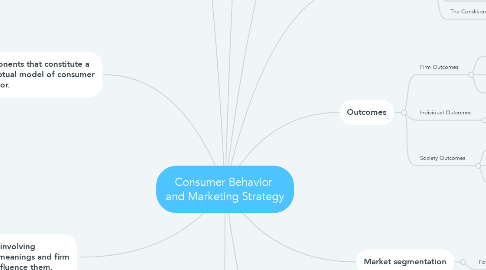
1. Marketing mix
1.1. The Product
1.1.1. Is anything a consumer acquires or might acquire to meet a perceived need.
1.2. Communications
1.2.1. include advertising, the sales force, public relations, packaging, and any other signal that the firm provides about itself and its products.
1.3. Price
1.3.1. Is the amount of money one must pay to obtain the right to use the product.
1.4. Distribution
1.4.1. Having the product available where target customers can buy it, is essential to success.
1.5. Service
1.5.1. Refers to auxiliary or peripheral activities that are performed to enhance the primary product or primary service.
2. Consumer behavior
2.1. Field
2.1.1. The study of individuals, groups, or organizations.
2.2. Proccesses
2.2.1. To select, secure, use, and dispose of products, services, experiences, or ideas
2.3. Keys aspects
2.3.1. 1. Consumer behavior is a complex, multidimensional process.
2.3.1.1. Consumer decisions are further complicated when the needs and wants of multiple individuals or groups are considered.
2.3.2. 2. Successful marketing decisions by firms, nonprofit organizations, and regulatory agencies require an understanding of the processes underlying consumer behavior.
2.3.2.1. About when and why consumers act in certain ways.
2.3.3. 3. Successful marketing decisions require organizations to collect information about the specific consumers involved in the marketing decision at hand.
2.3.3.1. Consumer decisions are heavily influenced by situation and product category.
2.3.4. 4. Marketing practices designed to influence consumer behavior involve ethical issues that affect the firm, the individual, and society.
2.3.4.1. The issues are not always obvious and many times involve trade-offs at different levels.
3. Components that constitute a conceptual model of consumer behavior.
3.1. External Influences
3.1.1. Culture Subculture Demographics Social Status Reference Groups Family Marketing Activities
3.2. Internal Influences
3.2.1. Perception Learning Memory Motives Personality Emotions Attitudes
3.3. Self-Concept and Lifestyle
3.3.1. Self-concept is the totality of an individual’s thoughts and feelings about him or herself.
3.3.2. Lifestyle is, quite simply, how one lives.
3.4. Consumer Decision Process
3.4.1. Result from perceived problems
3.5. Organizations and Regulation
3.5.1. Regulation is an aspect of consumer behavior that permeates marketer actions relating to all parts of our model and it warrants special attention as well.
4. Discuss issues involving consumption meanings and firm attempts to influence them.
4.1. Consumption has meaning beyond the satisfaction of minimum or basic consumer needs.
4.2. Some criticize marketers for their attempts to instill in, or amplify, consumer desires for products beyond minimum functional aspects.
4.3. The ethical implications of marketers’ actions in this regard are important to consider.
5. Market segmentation
5.1. Four steps
5.1.1. 1. Identifying product-related need sets.
5.1.1.1. Organizations approach market segmentation with a set of current and potential capabilities.
5.1.2. 2. Grouping customers with similar need sets.
5.1.2.1. Involves consumer research, including focus group interviews, surveys, and product concept tests
5.1.3. 3. Describing each group.
5.1.3.1. Describe demographics, lifestyles, and media usage.
5.1.4. 4. Selecting an attractive segment(s) to serve.
5.1.4.1. Select the target market
6. Outcomes
6.1. Firm Outcomes
6.1.1. Product Position
6.1.2. Sales and Profits
6.1.3. Customer Satisfaction
6.2. Individual Outcomes
6.2.1. Need Satisfaction
6.2.2. Injurious Consumption
6.3. Society Outcomes
6.3.1. Economic Outcomes
6.3.2. Physical Environment Outcomes
6.3.3. Social Welfare
7. Components
7.1. The Consumers
7.2. The Company
7.3. The Competitors
7.4. The Conditions
8. It begins with an analysis of the market the organization is considering.
8.1. Outcomes
8.1.1. Individual Firm Society
8.2. Consumer decision process
8.2.1. Product, Price, Distribution, Promotion, Service
8.2.2. Problem recognition Information search Alternative evaluation Purchase Use Evaluation
8.3. Marketing strategy
8.4. Market segmentation
8.4.1. Identify product-related need sets Group customers with similar need sets Describe each group Select attractive segment(s) to target
8.5. Market analysis
8.5.1. Company Competitors Conditions Consumers
9. The applications of consumer behavior.
9.1. Marketing Strategy
9.1.1. Marketing decisions based on explicit consumer behavior theory, assumptions, and research are more likely to be successful than those based on hunches or intuition, and thus create a competitive advantage.
9.2. Regulatory Policy
9.2.1. Exist to develop, interpret, and/or implement policies designed to protect and aid consumers.
9.3. Social Marketing
9.3.1. Is the application of marketing strategies and tactics to alter or create behaviors that have a positive effect on the targeted individuals or society as a whole.
9.4. Informed Individuals
9.4.1. These attempts occur in ads, in websites, on packages, as product features, in sales pitches, and in store environments.
10. Marketing strategy and consumer behavior
10.1. Customer value
10.1.1. Is the difference between all the benefits derived from a total product and all the costs of acquiring those benefits.
10.2. Marketing strategy
10.2.1. Is formulated in terms of the marketing mix
10.2.1.1. Involves
10.2.1.1.1. The product features, price, communications, distribution, and services that will provide customers with superior value.
10.3. Total product
10.3.1. Is presented to the target market, which is consistently engaged in processing information and making decisions designed to maintain or enhance its lifestyle
10.4. Consumer decisions
10.4.1. Intervenes between the marketing strategy (as implemented in the marketing mix) and the outcomes.
